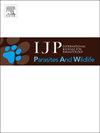亚华卡湖水系(哥伦比亚亚马逊河)水淹雨林栖息地的水生珊瑚蛇Micrurus surinamensis(居维叶,1817)(蛇类:蛇科)的肠道感染及隐虫科系统发育分析
IF 2.2
3区 医学
Q3 ECOLOGY
International Journal for Parasitology-Parasites and Wildlife
Pub Date : 2025-03-10
DOI:10.1016/j.ijppaw.2025.101055
引用次数: 0
摘要
本文描述了Acanthostomum yahuarcaquense Cajiao-Mora和Bullard n. sp. (Digenea:隐形虫科),基于我们在哥伦比亚莱蒂西亚的yahuaraca湖系统(亚马逊河)的洪水雨林栖息地捕获的水生珊瑚蛇Micrurus surinamensis(居维叶,1817)(蛇类:Elapidae)的肠道中收集的标本。我们把这个新种归为Acanthostomum Looss, 1899,因为它没有gonotyl,有一个细长的身体,多刺的被毛,漏斗状的口腔吸盘,周围有刺,每个喉部都有一个后外侧和近末端的孔,排泄囊臂伸向咽部的前方。这个新种与19个已被接受的同类不同之处在于,它有24-30个环棘(相比之下,少于20个或少于20个),一个从卵巢前缘延伸到身体后半部的卵泡(相对于睾丸或卵巢,但在身体前半部结束),一对细长对称的盲肠,每个都有一个肛门孔(相对于不对称的盲肠,一个单一的盲肠,或没有肛门孔)。我们的28S系统发育分析恢复了一个副aphyletic棘口虫(包括Neocladocystis spp.和Tanganyikatrema fususiforme kmentov本文章由计算机程序翻译,如有差异,请以英文原文为准。

Acanthostomum yahuarcaquense n. sp. (Digenea: Cryptogonimidae) infecting the intestine of an aquatic coral snake, Micrurus surinamensis (Cuvier, 1817) (Serpentes: Elapidae) from the flooded rainforest habitat of the Yahuarcaca Lake System (Amazon River, Colombia) and phylogenetic analysis of Cryptogonimidae
We herein describe Acanthostomum yahuarcaquense Cajiao-Mora and Bullard n. sp. (Digenea: Cryptogonimidae) based on specimens we collected from the intestine of an aquatic coral snake, Micrurus surinamensis (Cuvier, 1817) (Serpentes: Elapidae) captured within the flooded rainforest habitat of the Yahuarcaca Lake System (Amazon River) Leticia, Amazonas, Colombia. We assign the new species to Acanthostomum Looss, 1899because it lacks a gonotyl and has an elongate body, spinose tegument, funnel-shaped oral sucker with circumoral spines, ceca each having a posterolateral and nearly terminal pore, and excretory vesicle arms reaching anteriad to the pharynx. The new species differs from its 19 accepted congeners by having 24–30 circumoral spines (vs. fewer than 20 or aspinose), a vitellarium extending from the anterior margin of the ovary to the posterior half of the body (vs. from testis or ovary but ending in anterior half of body), and paired elongate, symmetrical ceca each having an anal pore (vs. asymmetrical ceca, a single cecum, or lacking anal pores). Our 28S phylogenetic analysis recovered a paraphyletic Acanthostomum (including Neocladocystis spp. and Tanganyikatrema fusiforme Kmentová, Georgieva, and Bray, 2020; both Cryptogonimidae) within a clade sister to other cryptogonimids. We discuss the implications of using nonugens and excessively short nucleotide sequences to compare species and to test phylogenetic relationships. Regarding advancing the systematics of the family, we discuss oral sucker shape and position, circumoral spine distribution, tegumental spine distribution, ceca symmetry, anal pore presence/absence and position, and gonotyl presence/absence and position as useful genus-level features. Many of these features remain indeterminate for several species. This is the first published study of a parasite infecting a tetrapod in the Yahuarcaca Lake System, first to record a parasite infecting a coral snake (Micrurus spp.) in Colombia, and only the second trematode species reported from the aquatic coral snake.
求助全文
通过发布文献求助,成功后即可免费获取论文全文。
去求助
来源期刊

International Journal for Parasitology-Parasites and Wildlife
Medicine-Infectious Diseases
CiteScore
3.80
自引率
5.60%
发文量
113
审稿时长
45 days
期刊介绍:
The International Journal for Parasitology: Parasites and Wildlife (IJP-PAW) publishes the results of original research on parasites of all wildlife, invertebrate and vertebrate. This includes free-ranging, wild populations, as well as captive wildlife, semi-domesticated species (e.g. reindeer) and farmed populations of recently domesticated or wild-captured species (e.g. cultured fishes). Articles on all aspects of wildlife parasitology are welcomed including taxonomy, biodiversity and distribution, ecology and epidemiology, population biology and host-parasite relationships. The impact of parasites on the health and conservation of wildlife is seen as an important area covered by the journal especially the potential role of environmental factors, for example climate. Also important to the journal is ''one health'' and the nature of interactions between wildlife, people and domestic animals, including disease emergence and zoonoses.
 求助内容:
求助内容: 应助结果提醒方式:
应助结果提醒方式:


